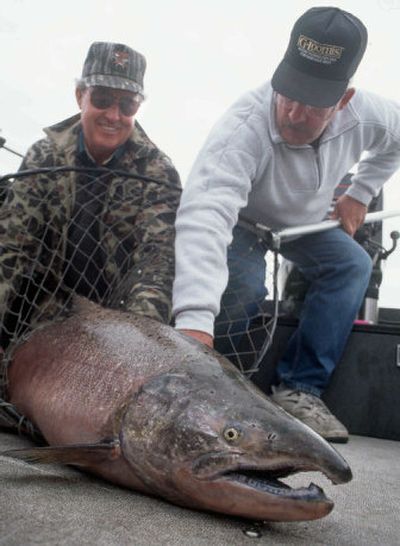Landers: Chinook too young to be mammoth

Two hot fishing topics emerged this week:
• Where are the behemoths in the Columbia River’s record run of chinook salmon?
• Is trout fishing dead at Badger Lake?
Read on for answers.
The fall chinook that return to the free-flowing Hanford Reach of the Columbia River are renown for including a few gargantuan survivors in the 50- to 60-pound range.
Some anglers say they’re seeing fewer of the giant fish being caught in the Vernita area and they wonder if the trophies are being targeted by downstream commercial gillnet fisheries.
Ron Roler, Washington Department of Fish and Wildlife Columbia River policy coordinator, said it’s largely a matter of percentages.
“In reality, yes, nets will be somewhat selective toward larger fish, but when the run is this big, that will make virtually no difference,” he said, referring to the record 1.06 million fall chinook predicted to enter the Columbia River system this season.
“Look at commercial fishery openings and then look and Bonneville Dam counts. If there was a dip, it was imperceptible. They’re catching a tiny fraction of what’s going by.”
The answer, he said, is in the age composition of the returning salmon.
Each year’s run of chinook from the ocean to freshwater includes ages ranging from 2 (jacks) to the rare 7-year-old monster.
“The big fish anglers occasionally catch are the 5- to 6-year-olds,” Roller said.
This year’s record run is dominated by 3- and 4 year-olds, weighing roughly 8-18 pounds, the product of two consecutive years of exceptional spring flows that boosted salmon smolts downstream through reservoirs to the ocean.
“The survival rate for young fish during those outmigrations was off the charts,” Roler said, noting that last year’s component of 3-year-olds was big.
However, the older fish age classes date back to years of smaller returns.
The 2012 fall chinook returns of upriver brights (bound for the Columbia and tributaries above Bonneville Dam) to the mouth of the Columbia totaled 298,100 fish (less than a third of this year’s run) in the following age groups:
• Age 3-162,900; age 4-84,800; age 5-50,300; age 6-1,000.
The numbers for the 2011 returns, totaling 322,100 adult chinooks, indicate how a subtle shift in the returns of 6-year-old salmon can give anglers three times better odds of catching a 50-pounder:
• Age 3-93,100; age 4-195,400; age 5-50,300; age 6-3,000.
When an age group comprises less than 1 percent of a run, the odds are slim that you’ll see one caught, Roler said.
“This year’s record run is powered by 3- and 4 year-olds, and that means every time you drop a hook, you’re most likely going to catch one of those fish.”
If this year shines for meat fishermen, the future is bright for trophy angling.
“Next year there will be a larger percentage of bigger fish, with the main power coming from 4- and 5 year-olds,” Roler said. “And in 2015, there should be plenty of big fish.”
The 2005 season, he noted, was an odds-on year for catching 50-pound kings in the Hanford Reach with 7,300 of the 6-year-olds in the mix. That’s seven times more of the monsters than in last year’s run.
“In 2015, I expect the number of sixes to be even higher,” Roler said.
Badger rehab nixed: The revival of trout fishing at Badger Lake, one of Washington’s most productive put-and-take fisheries for rainbows and cutthroats, is on hold at least for another year.
Washington Fish and Wildlife officials said Wednesday that they have canceled plans for a fall rotenone treatment that would rid the Spokane County lake of bass and sunfish to eliminate competition for a renewed trout fishery.
John Whalen, regional fisheries manager, said the agency was unable to get all water rights holders to sign a Department of Ecology agreement that precludes using lake water during the treatment period.
Badger has been managed for trout for more than 60 years. But in recent years, apparent illegal plants of bass and sunfish have degraded the trout fishery.
At a summer public meeting, bass anglers said Badger was one of the area’s hottest largemouth fisheries, with fish in the 4-plus pound range.
State fisheries biologists said the bass fishery was peaking and would degrade in the next few years. They said that managing for trout is more stable and serves a higher number of anglers in a year.
Badger Lake’s fishing season closed Tuesday. When it reopens on the fourth Saturday in April, it will have a token plant of trout, if any.
“We’ll be reconsidering a rehab for next year,” said Randall Osborne, district fisheries biologist. “But our June fish survey found that of 17,000 fish collected, 47 percent were pumpkinseed sunfish and 49 percent was largemouth and smallmouth bass. With those odds, we can’t afford to put many trout in the lake.”
The Williams Lake trout fishery also is in jeopardy, since it’s downstream from Badger and soon will be infested, too, he said.
“Trout fisheries generate the most interest in terms of families and businesses,” said Chris Donley, inland fisheries program manager. “I’d hate to lose Badger from the trout program.
“We’re down to just six trout-managed lakes in Spokane County and Badger can be one of the best.”
Contact Rich Landers at (509) 459-5508 or email richl@spokesman.com.